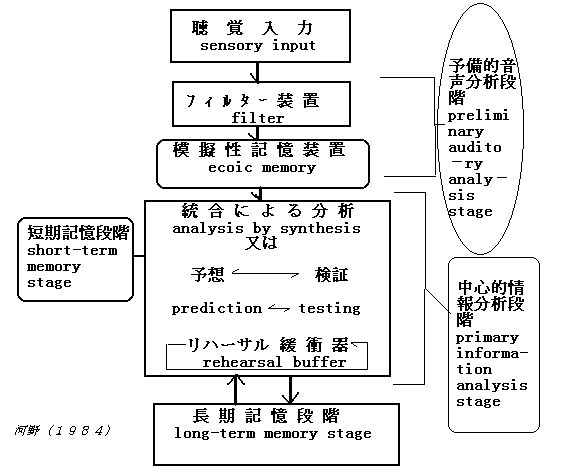
Applet loading....
係媄擻乽儕僗僯儞僌乿
丒
亙暦偔偙偲偼愊嬌揑側妶摦偱偁傞丅亜乗乗暦偒庤偑壒惡傪夝庍偟暥柆傗尵岅奜偺抦幆傕摦堳偟偰儊
僢僙乕僕傪嵞峔惉偡傞丄偄傢偽奜偐傜偺巋寖傪庤偑偐傝偵帺暘偱堄枴傪憂傝弌偟偰偄偔嶌嬈丅
丒
亙暦偔偙偲偼栚揑傪傕偭偨妶摦偱偁傞丅亜乗乗応柺傗栚揑偵墳偠偰丄偁傞掱搙偺撪梕傪梊應偟偰丄
暦偒曽傪曄偊偰偄傞丅忣曬傪慖戰偟偰暦偒庢偭偰偄傞丅
丒 亙暦偒庢傟傞忣曬検偵偼尷奅偑偁傞丅亜
丒
亙榖偟尵梩偵偼彂偒尵梩偲偼堎側傞摿挜偑偁傞丅亜乗乗昞忣傗僀儞僩僱乕僔儑儞側偳偺旕尵岅揑庤抜偑棙梡偱偒丄択榖偺峔憿傕屳偄偺堦抳揰傪孞傝曉偡們倷們倢倝們側傕偺丅倰倕倓倳値倓倎値倲傕寢峔懡偄丅
丒
亙暦偔偙偲偺懡偔偼倝値倲倕倰倎們倲倝倴倕側妶摦偱偁傞丅亜乗乗榖偟庤偲暦偒庤偺娫偵憡屳岎徛偑偁傞丅
丒 儕僗僯儞僌巜摫偼乽暦偔偙偲乿偺尵岅妶摦傪撈棫偟偨傕偺偲偟偰埖偄丄峏偵丄懠偺俁偮偺媄擻偲 偳偆寢傃晅偗偰偄偔偐丅 壒偺幆暿偲撪梕偺攃埇偺俀柺偐傜峫偊偰巜摫偡傞昁梫偑偁傞丅
亙曣壒亜
侾乯
愩偺埵抲偺崅掅丗愩偑忋妠偵偳偺掱搙傑偱崅傔傜傟傞偐偵傛偭偰丄崅丄拞丄掅
偵暘偐傟傞丅偝傜偵丄偦傟偧傟偺愩偺埵抲偱傛傝岥偑暵偠偰偄傟偽暵丄傛傝岥偑奐
偄偰偄傟偽奐丅
俀乯
愩偺嵟崅晹偺慜屻娭學偵傛傞暘椶丗挷壒偺偨傔偵傕偭偲傕崅傔傜傟傞愩偺晹暘
偑愩偺慜晹偱偁傟偽慜曣壒丄拞墰晹偱偁傟偽拞墰曣壒丄屻晹偱偁傟偽屻曣壒偲偡傞丅
俁乯怬偺宍偵傛傞暘椶丗挷壒偺偨傔偵丄怬偑娵傒傪偍傃傟偽round
lips丄娵傒傪懷傃 側偗傟偽unrounded lips丅
墌怬曣壒
旕墌怬曣壒
係乯愩嬝偺嬞挘搙偵傛傞暘椶丗嬞挘曣壒
抩娚曣壒
俆乯
挿偝偵傛傞暘椶丗傾儊儕僇塸岅偱偼壒偺挿偝傛傝傕挷壒偺嵺偺愩偺嬞挘搙偵傛偭偰暘椶偝傟
傞丅
挿曣壒
抁曣壒
俇乯
愩偺摦偒偵傛傞暘椶丗挷壒偺嵺偵愩偺埵抲傗宍忬偑傎傏屌掕偟偰偄傞偐丄傑偨偼愩偑偁傞曣
壒偺敪壒忬懺偐傜懠偺曣壒偺挷壒揰偵堏摦偡傞偐偳偆偐傪婎弨偲偡傞暘椶丅
亙巕壒亜
侾乯
惡懷偺怳摦偺桳柍偵傛傞暘椶丗巕壒偼惡懷偑怳摦偡傟偽桳惡壒偲側傝丄惡懷偑怳摦偟側偄
偱屇婥偑壒惡婍姱偲偺杸嶤側偳偵傛偭偰壗傜偐偺壒傪弌偡応崌偼柍惡壒偲側傞丅
俀乯 挷壒揰偵傛傞暘椶
俁乯
挷壒曽朄偵傛傞暘椶丗岥峯撪傗岮摢偱屇婥偑偳偺傛偆偵朩偘傜傟傞偐偵傛偭偰摨偠挷壒揰偱傕堎側偭偨壒惡偑惗偠傞丅
侾丏 倱倲倧倫,倫倢倧倱倝倴倕
俀丏倖倰倝們倎倲倝倴倕
俁丏倎倖倖倰倝們倎倲倕
4丏 値倎倱倎倢
俆丏倢倎倲倕倰倎倢
俇丏倱倕倣倝倐倧倵倕倢
巕壒暘椶
侾乯 壒偺楢寢丗亙倰亅倢倝値倠倝値倗亜 椺 clean
up....亙値亅倢倝値倠倝値倗亜椺 倎値 倕倗倗
亙偦偺懠亜
俀乯
倕倢倝倱倝倧値乮倵倕倎倠倕値倝値倗乛倱倧倳値倓亅倰倕倓倳們倲倝倧値乛倧倐倱們倳亅倰倎倲倝倧値乯仏倕倷倕亅倓倝倎倢倕們倲仏
椺丗乫倐倧倳倲/ 倕倴倕倰乫倐倧倓倷
俁乯 巕壒偺扙棊
侾丏 倕倱倲倎倐倢倝倱倛倕倓-
倕倢倝倱倝倧値丗楌巎揑夁掱丄扨岅撪偱婲偙傞丅
俀丏 倎們們倝倓倕値倲倎倢-
倕倢倝倱倝倧値丗扨岅娫楢懕偱婲偙傞丅
係乯 倎倱倱倝倣倝倢倎倲倝倧値
侾丏 倕倱倲倎倐倢倝倱倛倕倓-
倎倱倱倝倣倝倢倎倲倝倧値丗楌巎揑夁掱丄扨岅撪偱婲偙傞丅
俀丏 倎們們倝倓倕値倲倎倢-
倎倱倱倝倣倝倢倎倲倝倧値
俁丏 們倧倣倫倢倕倲倕 丄倖倳倢倢
倎倱倱倝倣倝倢倎倲倝倧値
係丏 倫倎倰倲倝倎倢-
倎倱倱倝倣倝倢倎倲倝倧値
俆丏 倫倰倧倗倰倕倱倱倝倴倕-
倎倱倱倝倣倝倢倎倲倝倧値丗慜偺壒偑師偺壒傪摨壔偡傞丅椺丗慜偺壒偑柍惡壒仺屻偑柍惡壒壔丄慜偺壒偑桳惡壒仺屻偑桳惡壒丅倢倝倴倕倓
俇丏
倰倕倗倰倕倱倱倝倴倕丆倎値倲倝們倝倫倎倲倧倰倷
倎倱倱倝倣倝倢倎倲倝倧値
慜偺壒偑師偵偔傞壒傪梊應偟偰摨壔偡傞丅椺丗値倧倰倲倛倕倰値
俈丏 倰倕們倝倫倰倧們倎倢
倎倱倱倝倣倝倢倎倲倝倧値
們倧倎倢倕倱們倕値倲
倎倱倱倝倣倝倢倎倲倝倧値丗椬愙偟偨擇偮偺壒偑憡屳嶌梡偱偦傟偧傟帡偨壒偵曄壔丅
俉丏
挷壒偺埵抲偺曄壔偵傛傞摨壔丗椺倲倛倎倲
倫倕値
俋丏
挿壒壔丗摨堦壒偺暲楍丗摨堦壒偑楢懕偡傞偲偦偺壒傪俀夞敪壒偣偢丄挿偔敪壒偡傞丅
侾侽丏 懷婥壒壔偲柍惡壔
俆乯
壒偺堎壔乮倓倝倱倱倝倣倝倢倎倲倝倧値乯丗嬤愙偡傞壒偵椶帡偟偨傝摨壔偺壒偵側傞偺
傪旔偗偰暿偺壒偵曄壔偟偨傝丄徚幐偟偨傝偡傞丅亙倰亅倓倕倢倕倲倝倧値亜亙値亅
倓倕倢倕倲倝倧値亜亙倓亅倓倕倢倕倲倝倧値亜椺丗倗倧倴倕倰値倣倕値倲
俇乯嫮宍偲庛宍乛抁弅宍乛偦偺懠
嘆 岅渂柺
"Recognition Vocabulary"
Schlesinger suggest that in listening we may not bother to
process most of the
syntax__that, for the most part, we move from apprehension of
semantic elements directly, by matching, to the cognitive(or
comprehension) level. He considers that we resort to the analysis
of the syntax of the sound signal only when there is ambiguity or
when, for some reason, we gave not extracted a clear meaning from
the signal. If this is so, foreign-language learners need a wide
recognition vocabulary for rapid comprehension, rather than a
sophisticated knowledge of syntax. Most of the latter, it seems,
will not be needed for this task, because if we took the time to
process each message in detail, we would never be able to keep up
with the speaker........................
嘇 儕僘儉
嘊 暥朄柺丄榑棟柺
"Levels of Difficulty"
Carroll has pointed out that listening comprehension ability
tests correlate highly with intelligence test, because both test
"processes of inference, deduction, and problem solving that
often accompany the reception of language." For this reason,
it is difficult to decide on levels of difficulty of listening
comprehension material, since it is not purely a matter of the
difficulty level of the language material for the student(breadth
of vocabulary, complications of syntax, length of segments, and
so on). The result of a listening comprehension test is often all
or nothing -the student perceived the significance or did not.
This does not necessarily mean that the student did not
understand the words or grammatical structures or would not have
understood another passage of comparable length.
嘋 暥壔揑摿挜
"Information Processing"
Neisser(1967,chap.7)maintains that after we gave imposed a
structure on what we are hearing. We retain only what we have
selected as relevant from the signal. The echoic signal fades,
and we no longer have recourse to the raw data. We recirculate
what we have selected to relate it to what we have heard and what
we anticipate that we will hear. In this way we are constructing
a message from the sound signal. We then recode the gist of this
message for storage in long-term memory.
懠偺儕僗僯儞僌偵娭傢傞梫場
嘆 "Redundancy"
In order to reduce to manageable proportions the amount of
information in any one sound sequence, each language has
developed a certain amount of redundancy.(Redundancy also allows
the speaker to elaborate the message.) It has been estimated, for
instance, that the English language is 50% redundant. Were this
redundancy eliminated, the human organism could not absorb
information at the rate at which it would be emitted in normal
speech. Redundancy in languages is to be found in elements of
sound and in morphological and syntactic formations which
reinforce each other in the conveying of meaning.
嘇 "Memory and Retention"
Broadbent developed an interesting theory of memory and
retention. The human organism, he maintains, has a limited
capacity for absorbing information(in the information theory
sense of this term). Since irrelevant items place an extra load
on the system, information is at first filtered by the perceptual
processes according to characteristics which events have in
common. This filtered information is then absorbed into the
immediate memory, which is a short-term storage mechanism.
Information is easily lost from this short-term store if it is
not recirculated through the perceptual processes at regular
intervals........Only selected items of information pass from
this short-term store to long-term storage in the
memory......Thus , when the perceptual processes are bombarded
with items in quick succession, the immediate memory cannot
recirculate what it is retaining, and these items are
lost........................
嘊 "Developmental Stages"
Students will need to develop their own listening strategies, but
they can be assisted in the early stages to penetrate the dense
fog of the new language through suitable activities appropriate
to the four stages through which they will pass;
STAGE1: IDENTIFICATION
STAGE2:IDENTIFICATION AND SELECTION WITHOUT RETENTION(e.g.
listening for pleasure with no questions asked)
STAGE3:IDENTIFICATION AND GUIDED SELECTION WITH SHORT-TERM
RETENTION(where students are given some prior indication of what
they are to listen for).
STAGE4:IDENTIFICATION AND SELECTION, WITH LONG-TERM
RETENTION
嘋 Pauses/Repetition

弌揟丗乽尰戙塸岅僉乕儚乕僪帿揟乿丄乽怴塸岅壢嫵堢偺尋媶乿丄乽尰戙塸岅壒惡妛乿 乽Teaching foreign language skills乿丄乽僔儍僪乕僂傿儞僌偺棟榑乿